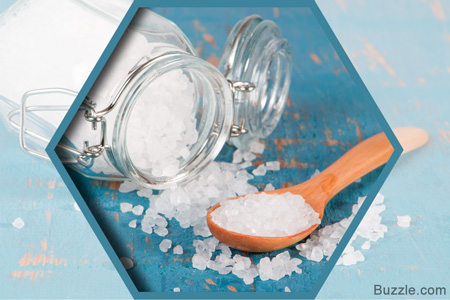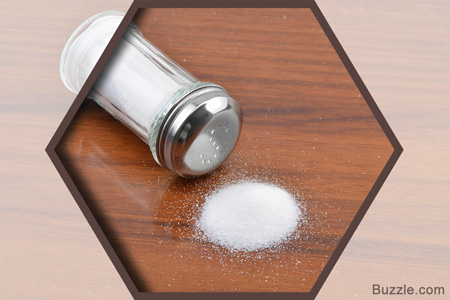
Salty Wages!
The historical significance of salt can be gauged by the fact that the Romans paid their soldiers salt as wages. It is believed that the word 'salary' originated from this practice.
Almost 75% of our body is made up of water. However, various types of salts are dissolved in it. Salts present in the cells and tissues facilitate various bodily processes such as muscle contraction, proper conduction of nerve impulses, and transport of nutrients into the cells. Sodium chloride (NaCl), which is often referred to as 'common salt', is the chemical compound which makes sea water salty. It is also present in the extracellular fluid of almost all multicellular organisms. NaCl can either be obtained from sea water or mined from underground deposits.
Table salt, sea salt, kosher salt, and iodized salt (which is a form of table salt with iodine added to it) are the four main types of salts available to us. Though there are other varieties of salt, in this article, we would only be discussing the differences between sea salt and table salt.
Table salt, sea salt, kosher salt, and iodized salt (which is a form of table salt with iodine added to it) are the four main types of salts available to us. Though there are other varieties of salt, in this article, we would only be discussing the differences between sea salt and table salt.

Sea salt

Table salt
Source of Extraction
Sea Salt
As the name suggests, this type of salt is extracted from the seas and oceans.
Table Salt
It can be extracted from the rock salt (halite), that is formed on the mineral beds due to drying of water bodies.
Processing
Sea Salt
This salt variety can be obtained with minimum processing.
It is extracted just by evaporating water from the sea or the ocean. This method is called 'Solar Evaporation'. To make it easier, sea water is channeled into man-made pools along protected shores, and is then left under the sun till all the water gets evaporated. Salt crystals are left behind in the pools after evaporation.
Sometimes it is produced by artificial heating, which gives away larger flakes of salt.
This process of salt production is quite expensive as compared to mining. However, considering the rich mineral content that is retained after processing, the expense is worth it.
Table Salt
It can be extracted using two methods- Mining and Solution Mining.
Mining involves rock salt mining, which is further divided into two methods: 'Cut and Blast Mining' and 'Continuous Mining'.
In solution mining, water is injected, with tremendous force, into the bore-wells drilled into the underground salt layers. The salt dissolves in water, converting it into brine. This brine is then extracted and pumped into the purification plant, wherein magnesium, calcium, potassium, and other trace minerals (considered as impurities) are removed. It is then sent for evaporation. Steam is used for heating the brine. This leads to the formation of small crystals of salt.
Chemical Properties
Sea Salt
Sodium Chloride: 97%
Potassium Chloride: 2%
Trace Minerals: 1%
Potassium Chloride: 2%
Trace Minerals: 1%
Table Salt
Sodium Chloride: 97.5 - 99%
Anti-caking Agents: 1 - 2.5%
Anti-caking Agents: 1 - 2.5%
Texture
Sea Salt
There is a lot of coarseness in the texture, which provides an evidence for it being unrefined. However, when it is dissolved or cooked, it loses all its minerals and becomes equivalent to table salt.
Table Salt
It has a fine texture, which makes it easier to mix. Anti-caking agents are added to avoid clumps and make it free-flowing. However, these additives may have negative effects on health.
Taste/Flavor
Sea Salt
It offers a strong flavor and a less salty taste. When you place a small amount of this natural salt on your tongue, it offers a sweeter and pleasant taste after a while. All these properties have made it a popular choice for chefs. It is used very often in French and Thai cuisines.
Table Salt
It has a strong salty taste due to the additives present in it. It also has a biting effect when you place a small amount of it on your tongue.
Color
Sea Salt
The color depends on mineral content and algae. The color would therefore vary, according to its location of extraction. The salt that is white in color is obtained from the surface of concentrated brine. Gray color indicates that it has a higher mineral and mud content, and is extracted from the bottom of the salt ponds.
Table Salt
The white color is due to bleaching and overall processing. The pinkish or grayish tint is lost from the salt due to the removal of minerals and trace elements.
Effects on Health
Sea Salt
It is important to note that both these salts contain almost the same amount of sodium chloride, and the health problems are because of excessive intake of sodium chloride. Hence, it is important to consume this salt in moderate quantities to avoid health problems.
Apart from being a flavor and taste enhancer, this salt is beneficial for supporting a strong immune system, proper brain function, healthy muscles, etc.
Another good thing is its natural form that is devoid of chemical additives, which are contributing factors in various health problems.
The best way to enjoy the benefits of this salt to the maximum, without draining away its minerals, is by sprinkling the salt crystals on prepared food. This will not only offer good flavor, taste and aroma to the food, but also help retain essential nutrients.
Table Salt
Excessive intake of salt is toxic for the body. The most common health problem caused by this salt is high blood pressure.
Increased intake of salt reduces the ability of your kidneys to remove water, and the extra fluid puts strain on the blood vessels, thereby increasing blood pressure.
Others problems that may result from high intake of refined salt are, arthritis, gout, red eyes, fluid retention, etc.
Salt pulls water from the bloodstream, which disturbs normal water absorption process. This may lead to excessive thirst and constipation in a person.
It can be safely concluded that there isn't any significant difference between the chemical properties of sea salt when compared with table salt. They have different texture, taste, flavor, and processing. Some retailers may sell sea salts that are fine-grained and white in color. If you want to enjoy the advantages of sea salt, be sure that it is the unrefined one and contains the minerals that gives it an edge over table salt. And remember, regardless of which type of salt you eat, you need to consume a very small amount of salt, to maintain your health. Processed foods should be excluded from your diet as they come with high amount of salt. Daily intake of sodium should be less than 2,300 milligrams. People above the age of 51 years, and those who have high blood pressure, diabetes, or chronic kidney problems should consume less than 1,500 milligrams of salt per day.
Hiç yorum yok:
Yorum Gönder
Yapacağınız yorumlar bizim için değerlidir. (Lütfen yorum bırakın)